Architecture of the Renaissance. Sources of occurrence, difference from preceding styles, typical interiors.
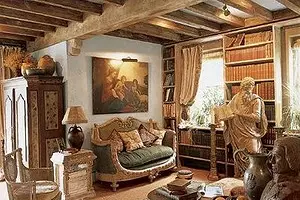
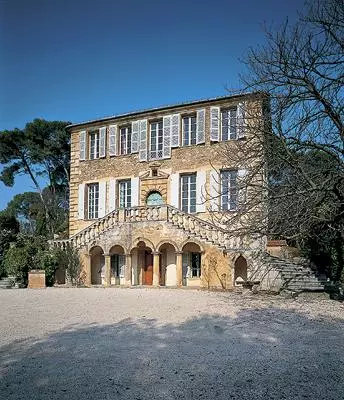
Residential House of the Renaissance, England. The windows are located on the plane of the facade strictly symmetrically. Fashionable Rust applied. The front door is indicated by a high staircase, which serves as a kind of balcony. Perhaps this is just such a balcony inspired Shakespeare the scene of the night date Romeo and Juliet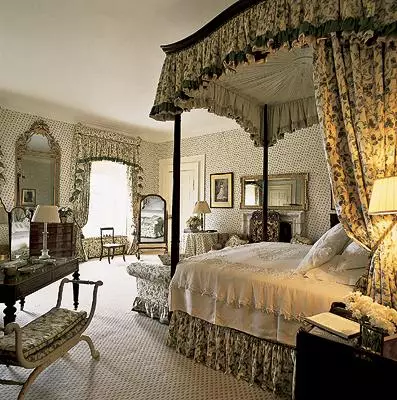
Soft lighting, "scissor" chair at the toilet table, a spacious bed with a slight canopy - "Here is Juliet, and these arches are beauty in a brilliant throne room transforms!"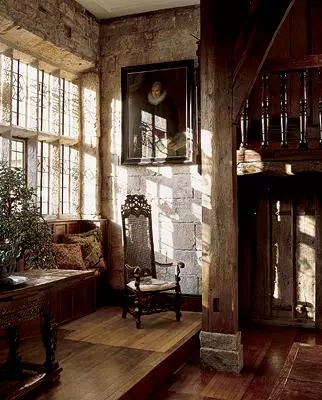
Main Hall at home XVV. vigracy Yorkshire (England). Here are preserved genuine wall cladding, wooden supports on a stone base and annetsol. Long bench stretched right under the window, exactly the reproducing "PraprabaBabushka"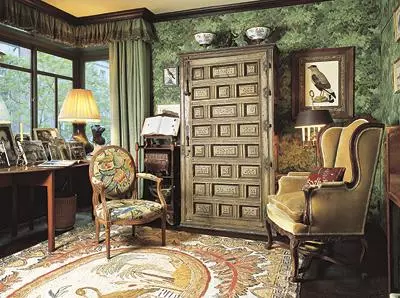
The renaissance cabinet archive externally looked like an architectural structure than for the interior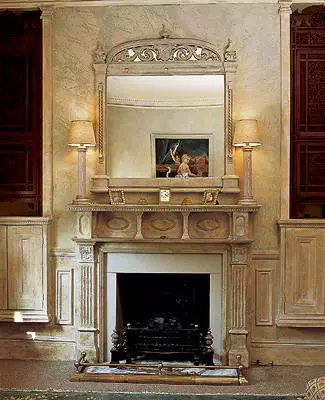
On both sides of the fireplace - flat pylons. Large calm surfaces of the marble wall emphasize the monumentality of the entire structure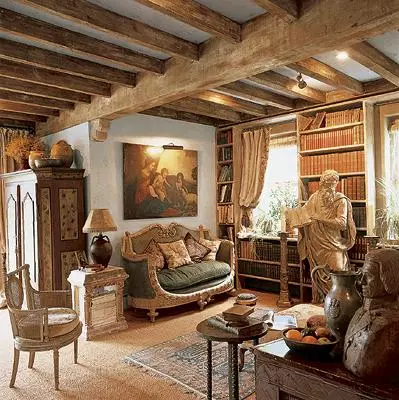
Renaissance Library Cabinet. Deserted a table next to the sofa. Despite the laws of architectonics, he, despite the small dimensions, produces a monumental impression, like a cathedral or palace. That is how the furniture forms in the Renaissance were interpreted. The same principle lies and at the base of stationary lamps in the form of detached columns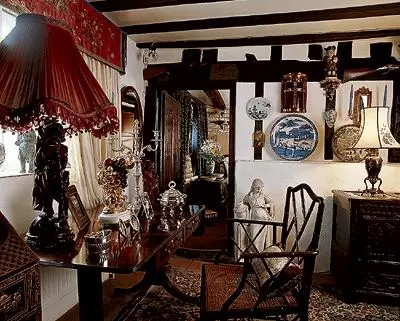
And in this office we see an example of a "parade" writing desk that serves as a "demo platform" for exquisite baubles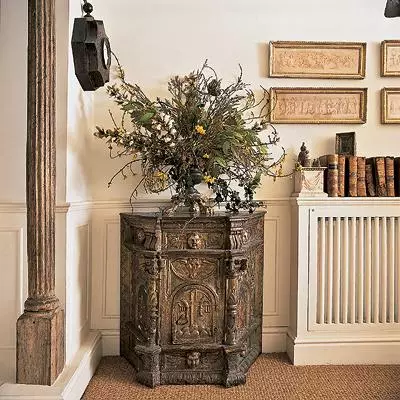
Another inclusion of the Renaissance Motive in the modern interior. The decorative stand is used a church department with symbolic images of evangelists and angels. Well, as a style accent, it is also possible, although as a massive acceptance is difficult to recommend
"Revival", "Renaissance" and very much musically sounding "Kreteno", "Quatrocheto", "Chinkvice" ... What lies behind these spicy terms? What kind of destruction was required to be revived and, most importantly, what? We admit that there was no destruction. Avota Revival of the traditions of antiquity, fairly subsided "Middle Ages", took place
What is the game coming to us?
And he prepares something eclipsed, heroic, taken from the deep "Greek well" of ideas. Determines the new Architecture of the Renaissance Antique Orders. The main types of buildings are clear in the proportions and at the same time plastically eloquently empty palaces and temple. The dreams characteristic of the Renaissance were not fully embodied in urban planning, much remained only on paper. Inherent style is "earth", centrically organized horizontal with a pronounced perspective, and not gothic aspiration.At this time, the drawing ceases to be only a working sketch and turns into a separate type of art. Individual maneer smear and stroke, the effect of incompleteness ("non-finito") and surface texture Customers begin to appreciate as independent artistic properties. Thus, a personified, author's creativity comes to replace medieval anonymity.
The main innovation in the work of the architect was the emergence of a project itself as an expression on preliminary plan paper. Elements of the future space, its cubature, as well as the mechanics of exposure to the viewer, - all this was calculated by the architects of revival with mathematical accuracy.
What difference was the renaissance interior from their predecessors? First, speaking figuratively, it became less emotional, that is, eliminated the random lighting effects and returned the balance of height, width, depth of gothic. The premises found a clear, complete beauty, became rational. Secondly, the Renaissance architecture received an understanding of the borders of the space and began to create premises of a clear approval. In addition, for the first time in the history of the painting of walls in houses and villas, not unlucky malya artisans began to do, but recognized artists.
Composition of residential buildings
It is mostly used by a centric, anfladnic, less often the radiation composition. Since the dome rises often over the building, bribing space turns into that center from which the entire remaining layout is "dancing". As a rule, under the dome is a large main hall. Around it, in accordance with the ancient samples, the architect revival builds minor volumes.
The appearance of the Urban Palace-Palazzo instead of the "detached" castle demanded both fundamentally new planning solutions. European bourgeoisie bankers, merchants, rich artisans, were the young and most susceptible, "advanced" customer of the interior. It sought even everyday life to subjugate the laws of beauty and benefit. Yes, and secular life actively invaded the private sphere, dictating their laws and rules to the inhabitants of the house. The giant halls of medieval feudal locks, in which the jelly could be posted, was now transformed into elegant reception of urban residences. The owner of the house is now decorating not only the premises for lush balls, but also its "workplace". Owners of banks and trading houses compete in the sophistication of tastes with the Dukes and Prince.
The palace or the city's house of the Renaissance, consisted of parade, residential and economic premises. The front part of the building included reception, dining rooms, cabinets and dance halls. "On the feast of ordinary cabins" the floors were covered with reeds, carpets were used as drapes and wall decorations. Installations were necessarily attended by supplies - cabinets with silence silver, faience, and even the porcelain, the ex-greater rare. However, in contrast to residential chambers, the representative zone is furnished scanty. The main subject here was the bench in all its varieties.
As a rule, the owner of the house had two cabinet-ordinary and front. The daily was located near the bedroom and did not differ in the luxury of the decoration, no big size, while the parade was located below, next to the living rooms and dining rooms, and served as a fee for official visitors. Kcabinets could adjoin the libraries, the fashion for which was distributed during this period not only in the environment nobility. The setting of the front office included, mainly massive tables. They were intended not so much to work as for the demonstration of rare and expensive things brought from exotic countries. Tables were covered with heavy carpet tablecloths and brocade fabrics. Nearby there were wide benches without backs, "softened" eastern pillows and carpets.
In general, the eastern motives are increasingly found in the decoration of European homes. The interior of the late Renaissance already knows such a beloved object, as a sofa borrowed from the Arab East. True, it is still "Prodivan", but already with pillows and a soft seat. Well, three hundred years later, his descendant will conquer everything without exception living rooms and cabins - from the most luxurious to the most modest, and Pushkin will pronounce the immortal: "ITEA fiction sofas for honor to us from Sultanov!"
Private rooms located on the upper floors were characterized by smaller sizes, but more diverse furnishing. A massive cabinet archive, ancestor of modern safes certainly, was certainly an array office. There is also a closet, a wardrobe, a bureau, a desk for writing. Furniture designed to work becomes much more convenient than medieval.
In general, furniture forms are still very archaic and more resemble the facades of architectural structures. The voucher of various objects there are columns, eaves and even the frontaths! You can recall the so-called Frankfurt cabinet, which could fit modern small-sized apartment. At the same time it should be noted that the furniture "gets up on the feet", pulls up. So, his Majesty of the wardrobe, book, dishwashed came to replace the low "all-consuming" chests. It came to never leave. However, the chest is still given in the house an honorable place, especially the wedding, which is a special pride of the family. He can be painted by scenes on the plots from the Gospel or from mythology. The predecessor and the sofa, and the chest was a long bench-caisson, also a kind of chest, but with a back and handles.
Workshop
Getting Started to recreate the style of Renaissance, remember that by nature this style is not decorative, but constructive. That is, it is created by architectural design, layout, volume and proportion, and not a form, ornament and color.Reconstruction
If you decide to reconstruct the premises, get ready together with the designer to "believe the algebra harmony". In the picture of the architect Bramte, it is excellent, as the proportions of the Renaissance building were calculated. Make a drawing and explication of your apartment as a whole and each room individually so that you can calculate and see the proportions of each room "Alabramte". At the same time, try to give your dwelling simple, clear features. If possible, all forms and volumes should strive for a square and a circle . It is not surprising that to achieve this goal you will have to lose most of the partitions. If they are not functional, they can be replaced by columns.
So, the proportions are square, the ratio of height and width of the room are one to two. This is if you do not intend to build a dome over your home. If the possibility and desire to create bribery space are available, the height becomes equal width.
The next important element of the interior column. Their size you have to be determined based on the square area. Keep in mind that the revival architects often used the second tier colonnade, which slides the hall around the perimeter. For the Renaissance Palazzo, there were no uncommon rooms, where the small columns of the second tier were highlighted the top row of windows. Hospital, for a modern urban apartment is unlikely. We will have enough decorative columns from artificial or natural materials. Column or half-column gives a brilliant ability to organize the necessary proportions by minimal means. Replace the upper tier of the colonnade may well be a mezzanine or decorative ornament (if the room is allowed).
What to say, Renaissance stylization is more to the face of a suburban residence than a city apartment. The unique image of the romantic palazzo or the villa wakes imagination and resembles the "hot night of Venice, a ghostly rain over Milan. Wet rain of the desired Kudri bathes Lucretia ..." No wonder Palladian style in rustic private construction is now experiencing another takeoff.
Decor of premises
With a serious design of the apartment we advise you to pay special attention to the finishing materials. Expressive rusty brick used for the outer finish of the Renaiss Master. This help the wall acquired a courageous, brutal view. Interior decoration was distinguished by the best grace. But since we decided to exploit the most typical and brightest techniques of style, the rustic (more precisely, it is imitation) can be applied in the interior. Of course, with special delicacy and sense of measure. Artificial stone is suitable in the style of "Rustic", "medieval castle", "feudal estate" or "slight face". Color, size, texture - your discretion. The imitation of a rough rushed surface is appropriate mainly in executive zones (swallow, living room). Do not forget that this finish from those that "take a lot on yourself" is very energetic and expressive, and if it is abused, the interior will be too "crushing".
The design of Renaissance premises was distinguished by bright colors and abundance of paintings. Fashion for illusory paintings spread not only on the front, but also for residential rooms. Ceilings, plafoons, lines were decorated with mythological scenes or plots from the life of the hosts of the house. The painted walls and the ceiling seemed to be spread the space halls, change their proportions. Brave experiments on their housing can make you move you on such a radical step like a bedroom or living room with frescoes. We handle that in unnecessary modesty you will not be accused, as well as in the standard of thinking. So imperceptibly we approached the decorative and picturesque stage of interior design. Please note that the Renaissance style gives preference to clean, fresh tones with several accents of outdoor colors.
The third stage of decoration is a stylist accent. It should be borne in mind that it is harder for the Renaissance than to simulate other styles, since in this case it is preferable to work with volumes, proportions, lighting, finishing. WHATS Same to play the role of a style accent can and reasonably selected piece of furniture.
Russian-Designer Phrasebook
Revival (Renaissance) - Epoch in the history of European culture of the XIII-XVI centuries, marked by the onset of the new time. The first sign, according to contemporaries, was the "flowering of art" after the long centuries of the medieval "decline". The flourishing of this "revived" artistic antique wisdom is precisely in this sense, the Italian word Rinascita is used for the first time (French Renaissance and all its European analogues occur). Art becomes equal to the laboratory, and the temple, where scientific knowledge is constantly intersecting with the God.
"The feeling of excellent", such a familiar for us is formulated precisely during the Renaissance. Of course, the burden of dwelling was less interesting to the best minds of the era than art or architecture, but also it experienced the shocks of novelty. The decoration of houses has been enriched with new forms of furniture, such as supplying dishes, closets of archives and secret meters.
Periodization. For a long time, the stages of the art of Italy - the birthplace of the Renaissance were served for periodization. Specially allocate: the introductory period, he is the same PRATINESSANCE or "DANTE AND GOTTO" (OK. 1260-1320), partially coinciding the period of Duty (XIIIV), then twitto (XV.), Quatrochetto (XVV) and Chinkovento (XVIV). These elegant names can be replaced by a little more official and common: early regeneration (XIV-XV centuries), high and later.
Perspective (Fr. Perspective from Lat. Perspicio-clearly see) - Art portray on the plane Three-dimensional space in accordance with that apparent change in the size, outlines, clarity of objects, which is due to the degree of remoteness from the observation point.
Proportion (Lat. Proportio) - proportionality, a certain ratio of parts of each other.
Kredentz - Chest or a low cabinet, common in Italy in the Renaissance Epoch. Covered with carvings and painting.
Kesson - Long bench, chest.
Luneta, Lainta (Fr. Lunette- Lunka) - arched opening in the arch or wall limited to the horizontal. Windows are placed in the opening lunts, the deaf decorated with painting and sculpture.
Plafond (PLAFOND) - painted or stucco ceiling; The work of monumental-decorative painting, decorating the overlap of the room.
Frankfurt cabinet - The object of furniture, which is originally (approximately in XIVV.) was produced in Frankfurt am Main. Such cabinets differed in massiveness, abundance of decor, architectural motifs. Vertical doors and lower boxes made them very convenient for storing a large number of things.
